Strategic Management Approaches: Analysis and Discussion
VerifiedAdded on 2019/10/30
|15
|3426
|245
Report
AI Summary
This report delves into the multifaceted realm of strategic management, analyzing various approaches prevalent in the global business landscape. It begins by exploring the standard linear approach, outlining its key stages and the importance of setting objectives, environmental analysis, and integrated planning. The report then critically examines the shortcomings of this approach, such as its complexity, time-consuming nature, and potential for implementation difficulties. Subsequently, it transitions to the stakeholder approach, emphasizing its focus on satisfying all stakeholders and integrating their interests for long-term sustainability. The dynamic capabilities approach is then discussed, highlighting its role in adapting to rapidly changing environments and achieving competitive advantages through innovation and reconfiguration. Finally, the sustainability approach to strategic management is explored, underscoring its importance for persistent organizational growth. The report concludes by summarizing the viability, limitations, and potential mitigations associated with each approach, advocating for further research to enhance business theory development.
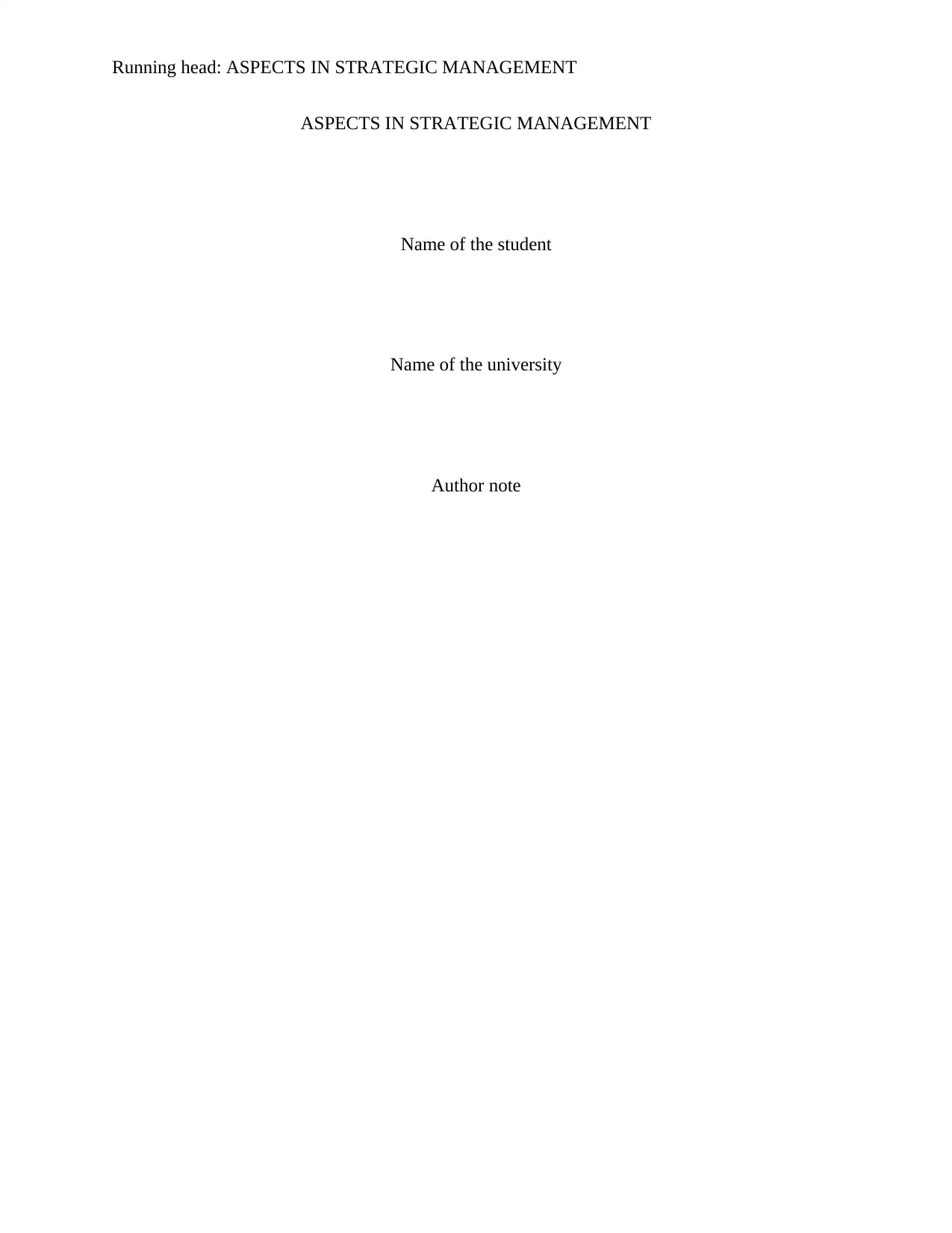
Running head: ASPECTS IN STRATEGIC MANAGEMENT
ASPECTS IN STRATEGIC MANAGEMENT
Name of the student
Name of the university
Author note
ASPECTS IN STRATEGIC MANAGEMENT
Name of the student
Name of the university
Author note
Paraphrase This Document
Need a fresh take? Get an instant paraphrase of this document with our AI Paraphraser
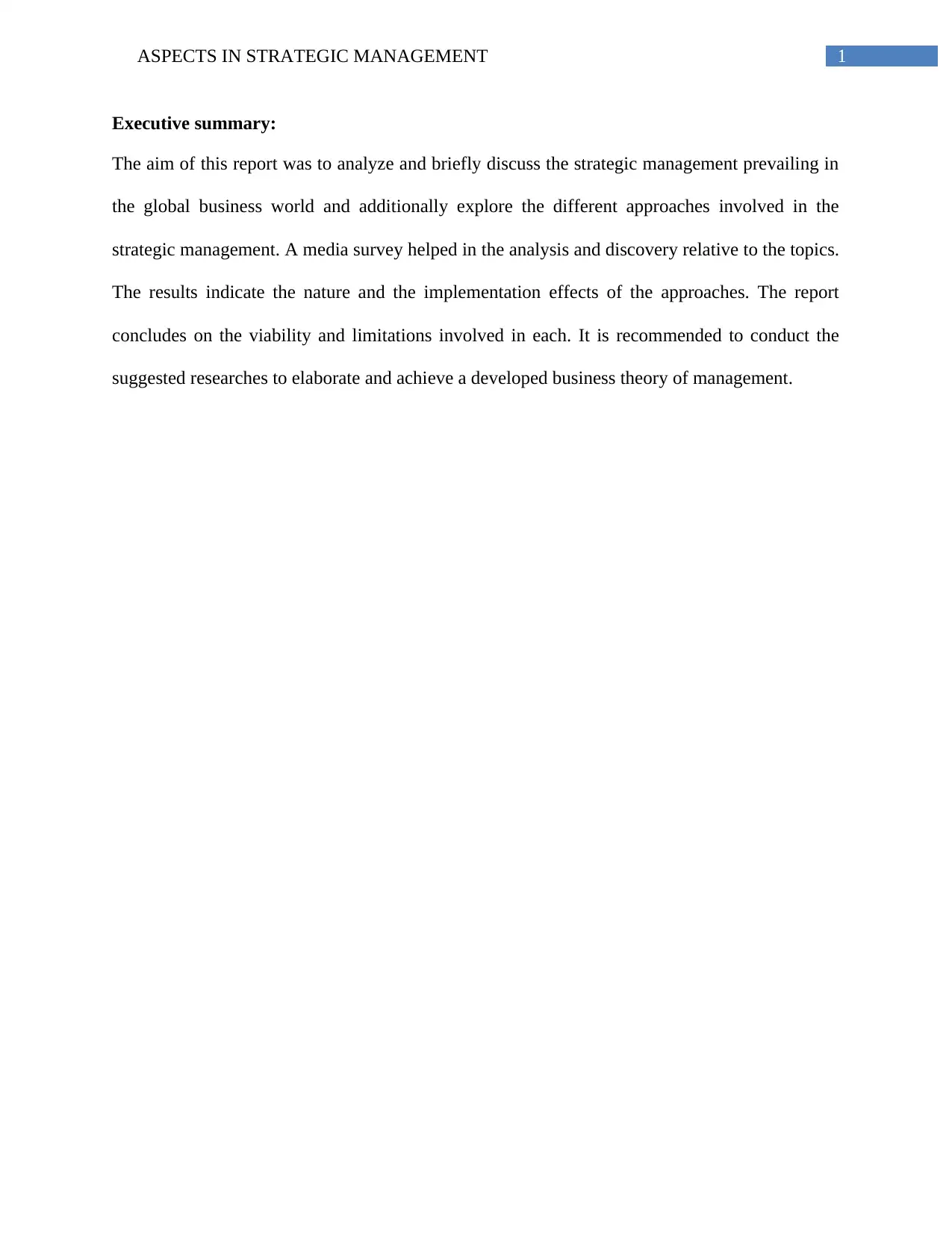
1ASPECTS IN STRATEGIC MANAGEMENT
Executive summary:
The aim of this report was to analyze and briefly discuss the strategic management prevailing in
the global business world and additionally explore the different approaches involved in the
strategic management. A media survey helped in the analysis and discovery relative to the topics.
The results indicate the nature and the implementation effects of the approaches. The report
concludes on the viability and limitations involved in each. It is recommended to conduct the
suggested researches to elaborate and achieve a developed business theory of management.
Executive summary:
The aim of this report was to analyze and briefly discuss the strategic management prevailing in
the global business world and additionally explore the different approaches involved in the
strategic management. A media survey helped in the analysis and discovery relative to the topics.
The results indicate the nature and the implementation effects of the approaches. The report
concludes on the viability and limitations involved in each. It is recommended to conduct the
suggested researches to elaborate and achieve a developed business theory of management.
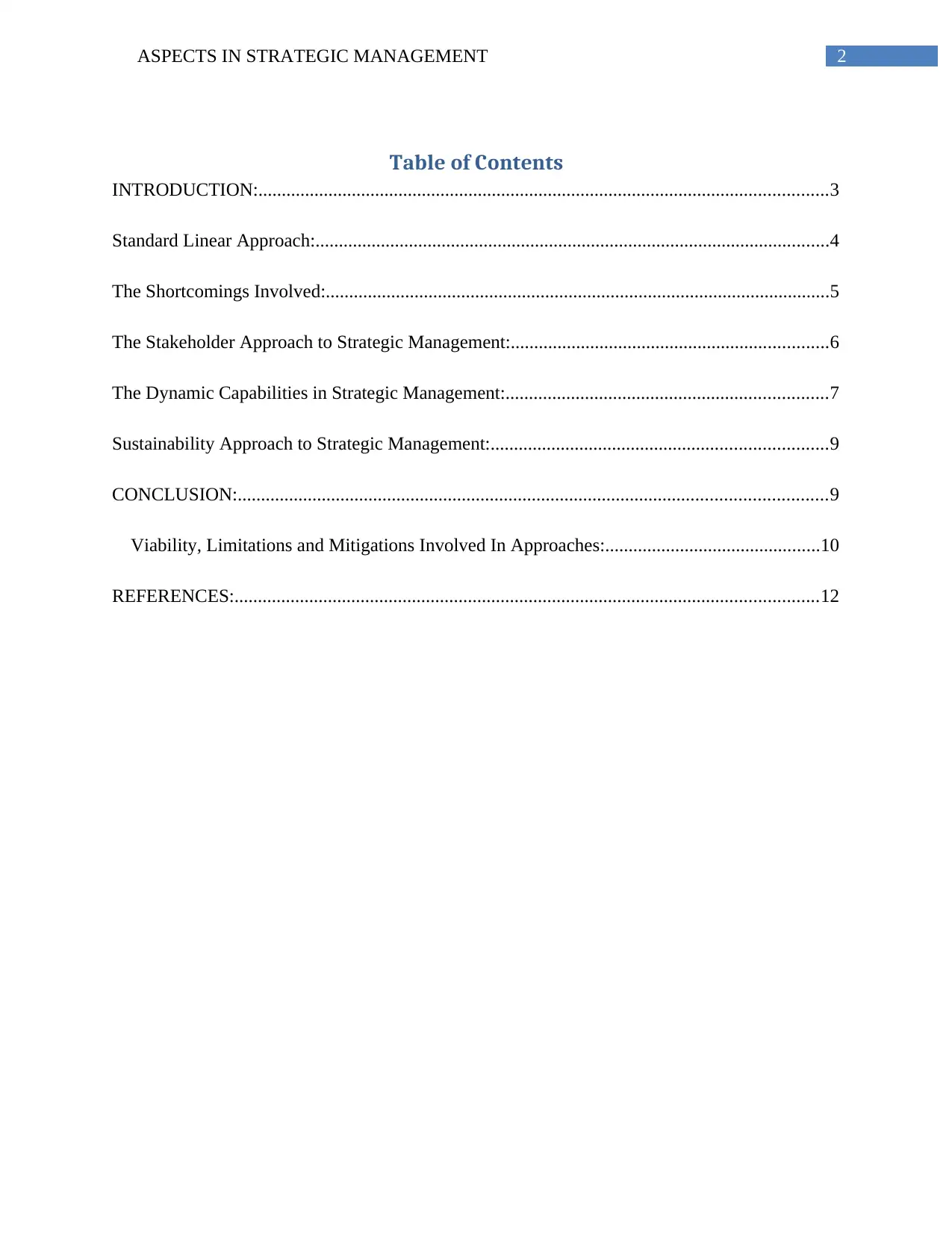
2ASPECTS IN STRATEGIC MANAGEMENT
Table of Contents
INTRODUCTION:..........................................................................................................................3
Standard Linear Approach:..............................................................................................................4
The Shortcomings Involved:............................................................................................................5
The Stakeholder Approach to Strategic Management:....................................................................6
The Dynamic Capabilities in Strategic Management:.....................................................................7
Sustainability Approach to Strategic Management:........................................................................9
CONCLUSION:..............................................................................................................................9
Viability, Limitations and Mitigations Involved In Approaches:..............................................10
REFERENCES:.............................................................................................................................12
Table of Contents
INTRODUCTION:..........................................................................................................................3
Standard Linear Approach:..............................................................................................................4
The Shortcomings Involved:............................................................................................................5
The Stakeholder Approach to Strategic Management:....................................................................6
The Dynamic Capabilities in Strategic Management:.....................................................................7
Sustainability Approach to Strategic Management:........................................................................9
CONCLUSION:..............................................................................................................................9
Viability, Limitations and Mitigations Involved In Approaches:..............................................10
REFERENCES:.............................................................................................................................12
⊘ This is a preview!⊘
Do you want full access?
Subscribe today to unlock all pages.

Trusted by 1+ million students worldwide
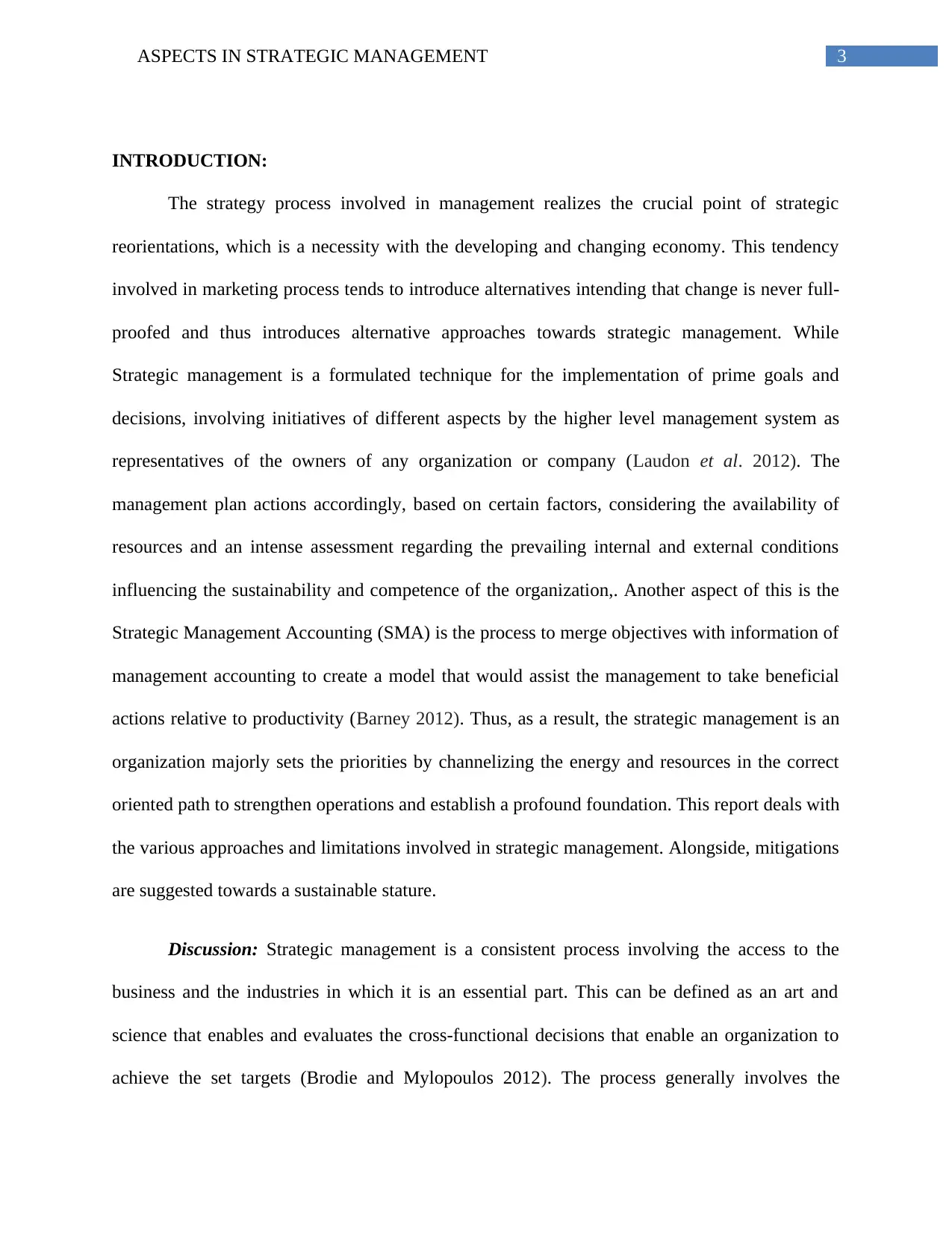
3ASPECTS IN STRATEGIC MANAGEMENT
INTRODUCTION:
The strategy process involved in management realizes the crucial point of strategic
reorientations, which is a necessity with the developing and changing economy. This tendency
involved in marketing process tends to introduce alternatives intending that change is never full-
proofed and thus introduces alternative approaches towards strategic management. While
Strategic management is a formulated technique for the implementation of prime goals and
decisions, involving initiatives of different aspects by the higher level management system as
representatives of the owners of any organization or company (Laudon et al. 2012). The
management plan actions accordingly, based on certain factors, considering the availability of
resources and an intense assessment regarding the prevailing internal and external conditions
influencing the sustainability and competence of the organization,. Another aspect of this is the
Strategic Management Accounting (SMA) is the process to merge objectives with information of
management accounting to create a model that would assist the management to take beneficial
actions relative to productivity (Barney 2012). Thus, as a result, the strategic management is an
organization majorly sets the priorities by channelizing the energy and resources in the correct
oriented path to strengthen operations and establish a profound foundation. This report deals with
the various approaches and limitations involved in strategic management. Alongside, mitigations
are suggested towards a sustainable stature.
Discussion: Strategic management is a consistent process involving the access to the
business and the industries in which it is an essential part. This can be defined as an art and
science that enables and evaluates the cross-functional decisions that enable an organization to
achieve the set targets (Brodie and Mylopoulos 2012). The process generally involves the
INTRODUCTION:
The strategy process involved in management realizes the crucial point of strategic
reorientations, which is a necessity with the developing and changing economy. This tendency
involved in marketing process tends to introduce alternatives intending that change is never full-
proofed and thus introduces alternative approaches towards strategic management. While
Strategic management is a formulated technique for the implementation of prime goals and
decisions, involving initiatives of different aspects by the higher level management system as
representatives of the owners of any organization or company (Laudon et al. 2012). The
management plan actions accordingly, based on certain factors, considering the availability of
resources and an intense assessment regarding the prevailing internal and external conditions
influencing the sustainability and competence of the organization,. Another aspect of this is the
Strategic Management Accounting (SMA) is the process to merge objectives with information of
management accounting to create a model that would assist the management to take beneficial
actions relative to productivity (Barney 2012). Thus, as a result, the strategic management is an
organization majorly sets the priorities by channelizing the energy and resources in the correct
oriented path to strengthen operations and establish a profound foundation. This report deals with
the various approaches and limitations involved in strategic management. Alongside, mitigations
are suggested towards a sustainable stature.
Discussion: Strategic management is a consistent process involving the access to the
business and the industries in which it is an essential part. This can be defined as an art and
science that enables and evaluates the cross-functional decisions that enable an organization to
achieve the set targets (Brodie and Mylopoulos 2012). The process generally involves the
Paraphrase This Document
Need a fresh take? Get an instant paraphrase of this document with our AI Paraphraser
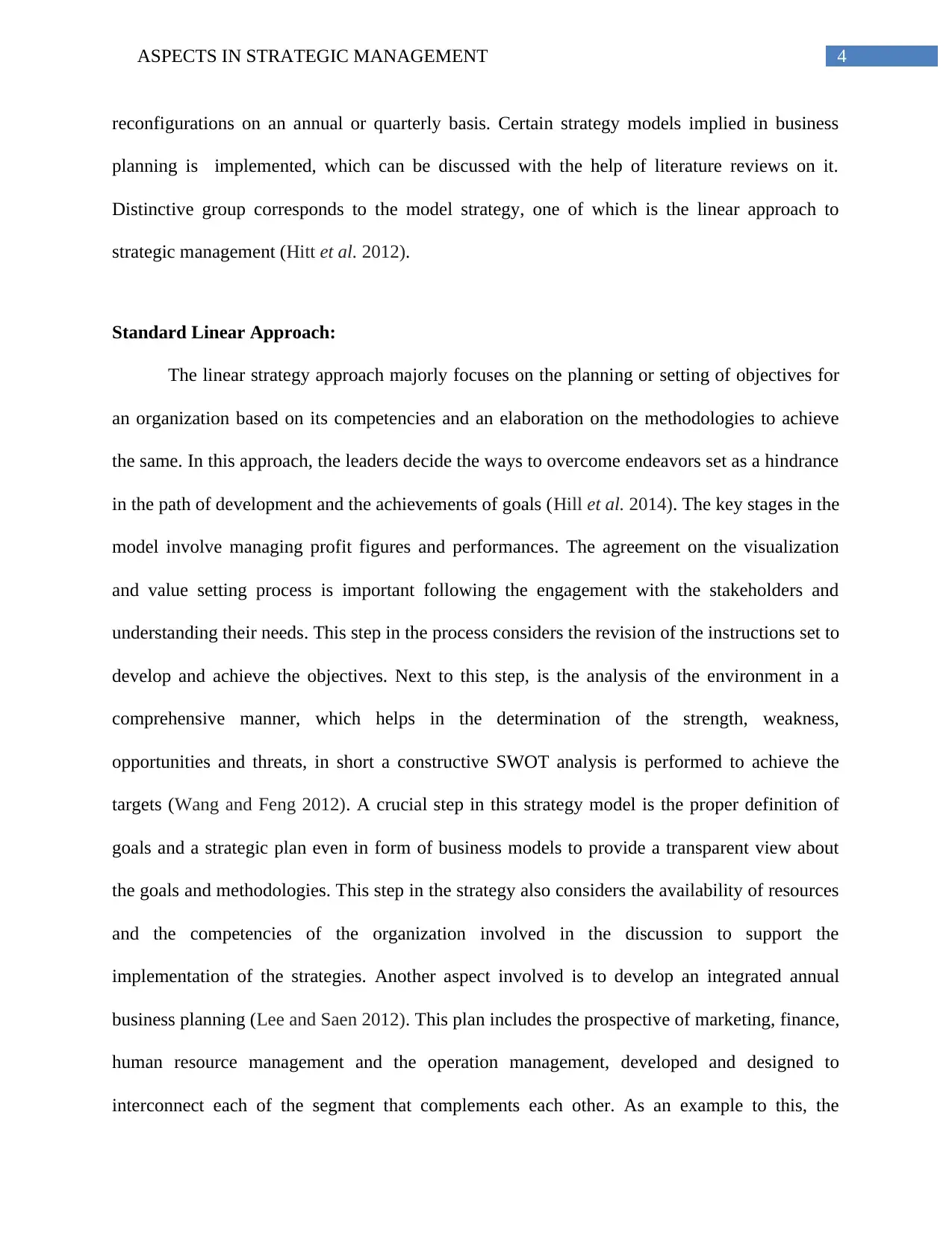
4ASPECTS IN STRATEGIC MANAGEMENT
reconfigurations on an annual or quarterly basis. Certain strategy models implied in business
planning is implemented, which can be discussed with the help of literature reviews on it.
Distinctive group corresponds to the model strategy, one of which is the linear approach to
strategic management (Hitt et al. 2012).
Standard Linear Approach:
The linear strategy approach majorly focuses on the planning or setting of objectives for
an organization based on its competencies and an elaboration on the methodologies to achieve
the same. In this approach, the leaders decide the ways to overcome endeavors set as a hindrance
in the path of development and the achievements of goals (Hill et al. 2014). The key stages in the
model involve managing profit figures and performances. The agreement on the visualization
and value setting process is important following the engagement with the stakeholders and
understanding their needs. This step in the process considers the revision of the instructions set to
develop and achieve the objectives. Next to this step, is the analysis of the environment in a
comprehensive manner, which helps in the determination of the strength, weakness,
opportunities and threats, in short a constructive SWOT analysis is performed to achieve the
targets (Wang and Feng 2012). A crucial step in this strategy model is the proper definition of
goals and a strategic plan even in form of business models to provide a transparent view about
the goals and methodologies. This step in the strategy also considers the availability of resources
and the competencies of the organization involved in the discussion to support the
implementation of the strategies. Another aspect involved is to develop an integrated annual
business planning (Lee and Saen 2012). This plan includes the prospective of marketing, finance,
human resource management and the operation management, developed and designed to
interconnect each of the segment that complements each other. As an example to this, the
reconfigurations on an annual or quarterly basis. Certain strategy models implied in business
planning is implemented, which can be discussed with the help of literature reviews on it.
Distinctive group corresponds to the model strategy, one of which is the linear approach to
strategic management (Hitt et al. 2012).
Standard Linear Approach:
The linear strategy approach majorly focuses on the planning or setting of objectives for
an organization based on its competencies and an elaboration on the methodologies to achieve
the same. In this approach, the leaders decide the ways to overcome endeavors set as a hindrance
in the path of development and the achievements of goals (Hill et al. 2014). The key stages in the
model involve managing profit figures and performances. The agreement on the visualization
and value setting process is important following the engagement with the stakeholders and
understanding their needs. This step in the process considers the revision of the instructions set to
develop and achieve the objectives. Next to this step, is the analysis of the environment in a
comprehensive manner, which helps in the determination of the strength, weakness,
opportunities and threats, in short a constructive SWOT analysis is performed to achieve the
targets (Wang and Feng 2012). A crucial step in this strategy model is the proper definition of
goals and a strategic plan even in form of business models to provide a transparent view about
the goals and methodologies. This step in the strategy also considers the availability of resources
and the competencies of the organization involved in the discussion to support the
implementation of the strategies. Another aspect involved is to develop an integrated annual
business planning (Lee and Saen 2012). This plan includes the prospective of marketing, finance,
human resource management and the operation management, developed and designed to
interconnect each of the segment that complements each other. As an example to this, the
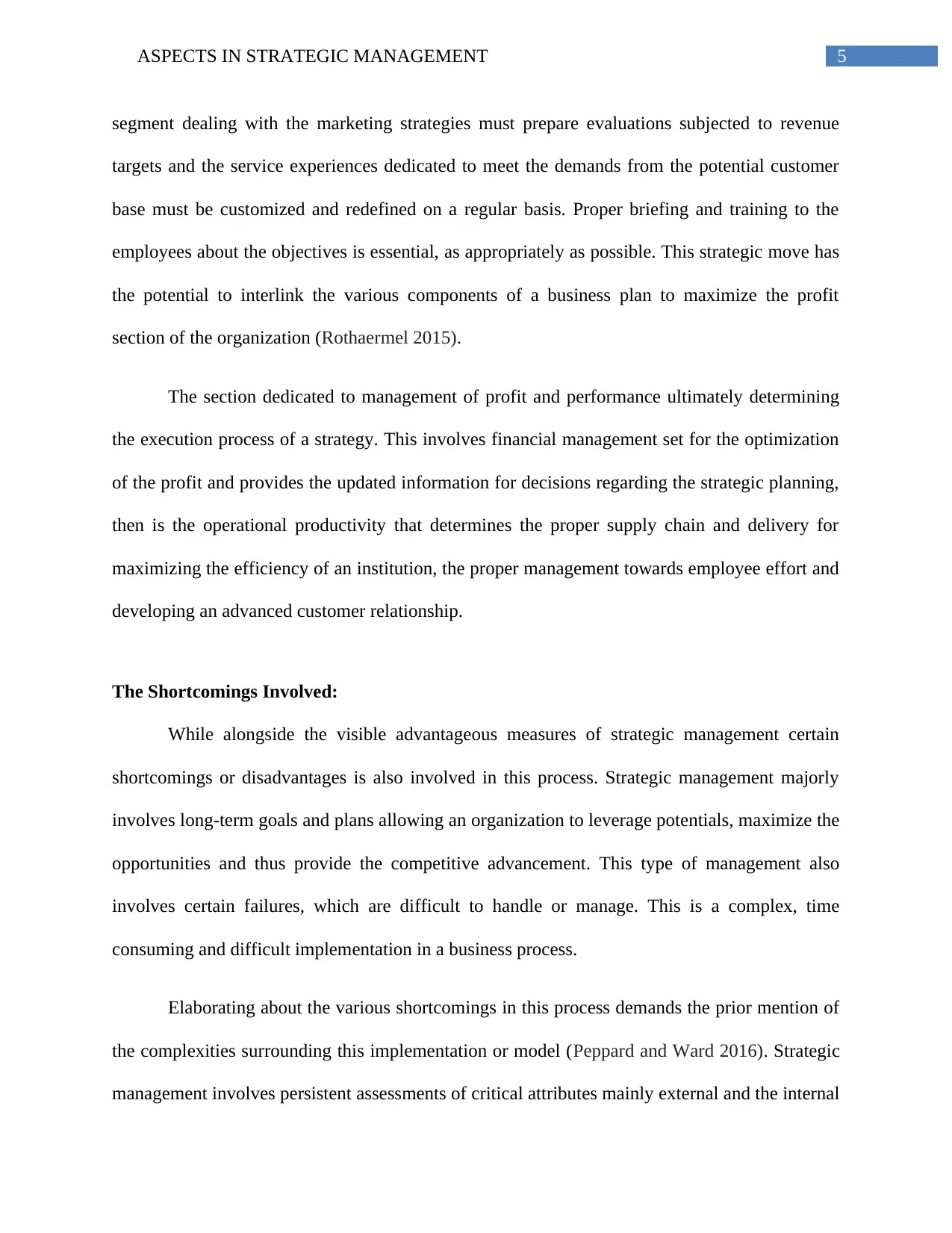
5ASPECTS IN STRATEGIC MANAGEMENT
segment dealing with the marketing strategies must prepare evaluations subjected to revenue
targets and the service experiences dedicated to meet the demands from the potential customer
base must be customized and redefined on a regular basis. Proper briefing and training to the
employees about the objectives is essential, as appropriately as possible. This strategic move has
the potential to interlink the various components of a business plan to maximize the profit
section of the organization (Rothaermel 2015).
The section dedicated to management of profit and performance ultimately determining
the execution process of a strategy. This involves financial management set for the optimization
of the profit and provides the updated information for decisions regarding the strategic planning,
then is the operational productivity that determines the proper supply chain and delivery for
maximizing the efficiency of an institution, the proper management towards employee effort and
developing an advanced customer relationship.
The Shortcomings Involved:
While alongside the visible advantageous measures of strategic management certain
shortcomings or disadvantages is also involved in this process. Strategic management majorly
involves long-term goals and plans allowing an organization to leverage potentials, maximize the
opportunities and thus provide the competitive advancement. This type of management also
involves certain failures, which are difficult to handle or manage. This is a complex, time
consuming and difficult implementation in a business process.
Elaborating about the various shortcomings in this process demands the prior mention of
the complexities surrounding this implementation or model (Peppard and Ward 2016). Strategic
management involves persistent assessments of critical attributes mainly external and the internal
segment dealing with the marketing strategies must prepare evaluations subjected to revenue
targets and the service experiences dedicated to meet the demands from the potential customer
base must be customized and redefined on a regular basis. Proper briefing and training to the
employees about the objectives is essential, as appropriately as possible. This strategic move has
the potential to interlink the various components of a business plan to maximize the profit
section of the organization (Rothaermel 2015).
The section dedicated to management of profit and performance ultimately determining
the execution process of a strategy. This involves financial management set for the optimization
of the profit and provides the updated information for decisions regarding the strategic planning,
then is the operational productivity that determines the proper supply chain and delivery for
maximizing the efficiency of an institution, the proper management towards employee effort and
developing an advanced customer relationship.
The Shortcomings Involved:
While alongside the visible advantageous measures of strategic management certain
shortcomings or disadvantages is also involved in this process. Strategic management majorly
involves long-term goals and plans allowing an organization to leverage potentials, maximize the
opportunities and thus provide the competitive advancement. This type of management also
involves certain failures, which are difficult to handle or manage. This is a complex, time
consuming and difficult implementation in a business process.
Elaborating about the various shortcomings in this process demands the prior mention of
the complexities surrounding this implementation or model (Peppard and Ward 2016). Strategic
management involves persistent assessments of critical attributes mainly external and the internal
⊘ This is a preview!⊘
Do you want full access?
Subscribe today to unlock all pages.

Trusted by 1+ million students worldwide
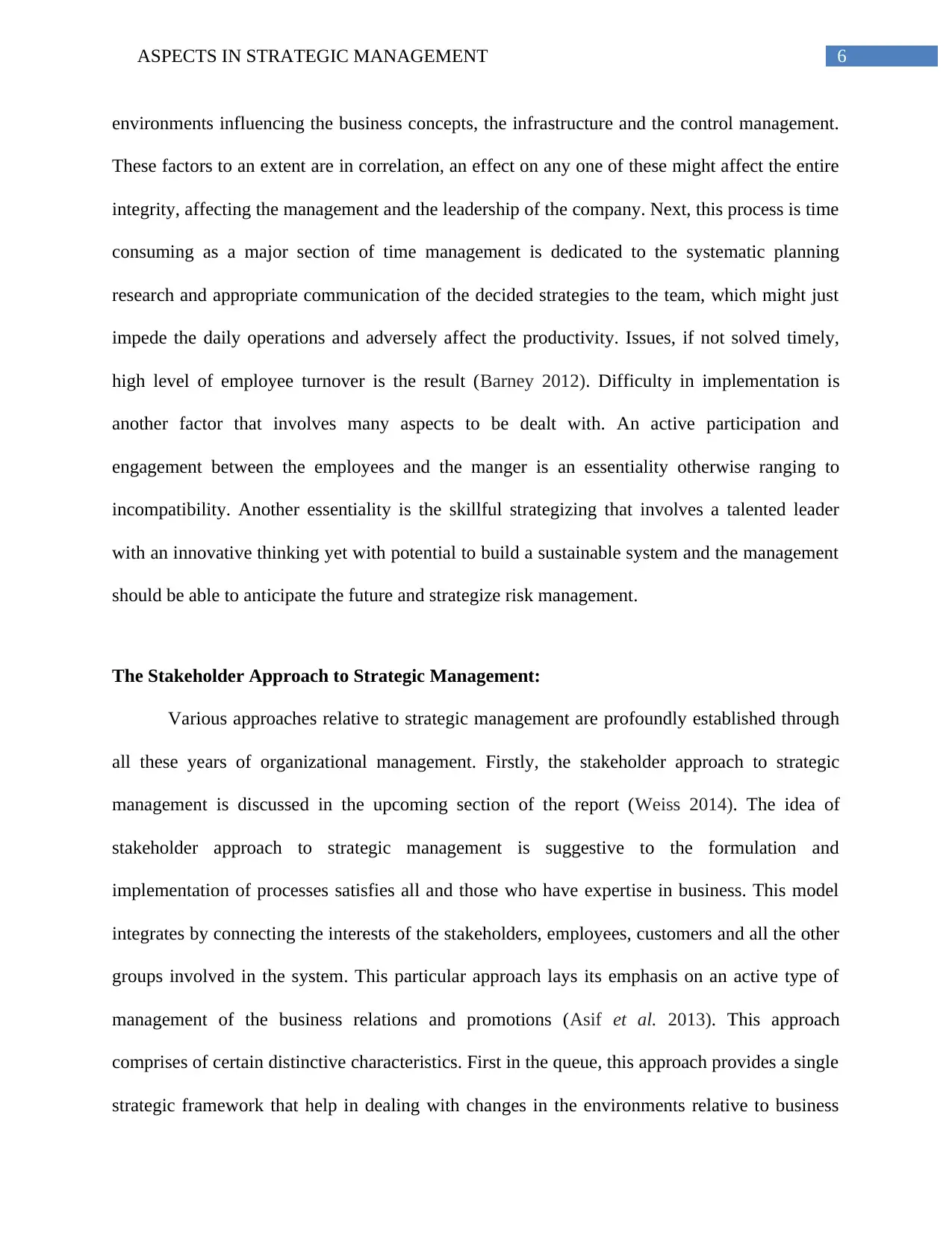
6ASPECTS IN STRATEGIC MANAGEMENT
environments influencing the business concepts, the infrastructure and the control management.
These factors to an extent are in correlation, an effect on any one of these might affect the entire
integrity, affecting the management and the leadership of the company. Next, this process is time
consuming as a major section of time management is dedicated to the systematic planning
research and appropriate communication of the decided strategies to the team, which might just
impede the daily operations and adversely affect the productivity. Issues, if not solved timely,
high level of employee turnover is the result (Barney 2012). Difficulty in implementation is
another factor that involves many aspects to be dealt with. An active participation and
engagement between the employees and the manger is an essentiality otherwise ranging to
incompatibility. Another essentiality is the skillful strategizing that involves a talented leader
with an innovative thinking yet with potential to build a sustainable system and the management
should be able to anticipate the future and strategize risk management.
The Stakeholder Approach to Strategic Management:
Various approaches relative to strategic management are profoundly established through
all these years of organizational management. Firstly, the stakeholder approach to strategic
management is discussed in the upcoming section of the report (Weiss 2014). The idea of
stakeholder approach to strategic management is suggestive to the formulation and
implementation of processes satisfies all and those who have expertise in business. This model
integrates by connecting the interests of the stakeholders, employees, customers and all the other
groups involved in the system. This particular approach lays its emphasis on an active type of
management of the business relations and promotions (Asif et al. 2013). This approach
comprises of certain distinctive characteristics. First in the queue, this approach provides a single
strategic framework that help in dealing with changes in the environments relative to business
environments influencing the business concepts, the infrastructure and the control management.
These factors to an extent are in correlation, an effect on any one of these might affect the entire
integrity, affecting the management and the leadership of the company. Next, this process is time
consuming as a major section of time management is dedicated to the systematic planning
research and appropriate communication of the decided strategies to the team, which might just
impede the daily operations and adversely affect the productivity. Issues, if not solved timely,
high level of employee turnover is the result (Barney 2012). Difficulty in implementation is
another factor that involves many aspects to be dealt with. An active participation and
engagement between the employees and the manger is an essentiality otherwise ranging to
incompatibility. Another essentiality is the skillful strategizing that involves a talented leader
with an innovative thinking yet with potential to build a sustainable system and the management
should be able to anticipate the future and strategize risk management.
The Stakeholder Approach to Strategic Management:
Various approaches relative to strategic management are profoundly established through
all these years of organizational management. Firstly, the stakeholder approach to strategic
management is discussed in the upcoming section of the report (Weiss 2014). The idea of
stakeholder approach to strategic management is suggestive to the formulation and
implementation of processes satisfies all and those who have expertise in business. This model
integrates by connecting the interests of the stakeholders, employees, customers and all the other
groups involved in the system. This particular approach lays its emphasis on an active type of
management of the business relations and promotions (Asif et al. 2013). This approach
comprises of certain distinctive characteristics. First in the queue, this approach provides a single
strategic framework that help in dealing with changes in the environments relative to business
Paraphrase This Document
Need a fresh take? Get an instant paraphrase of this document with our AI Paraphraser
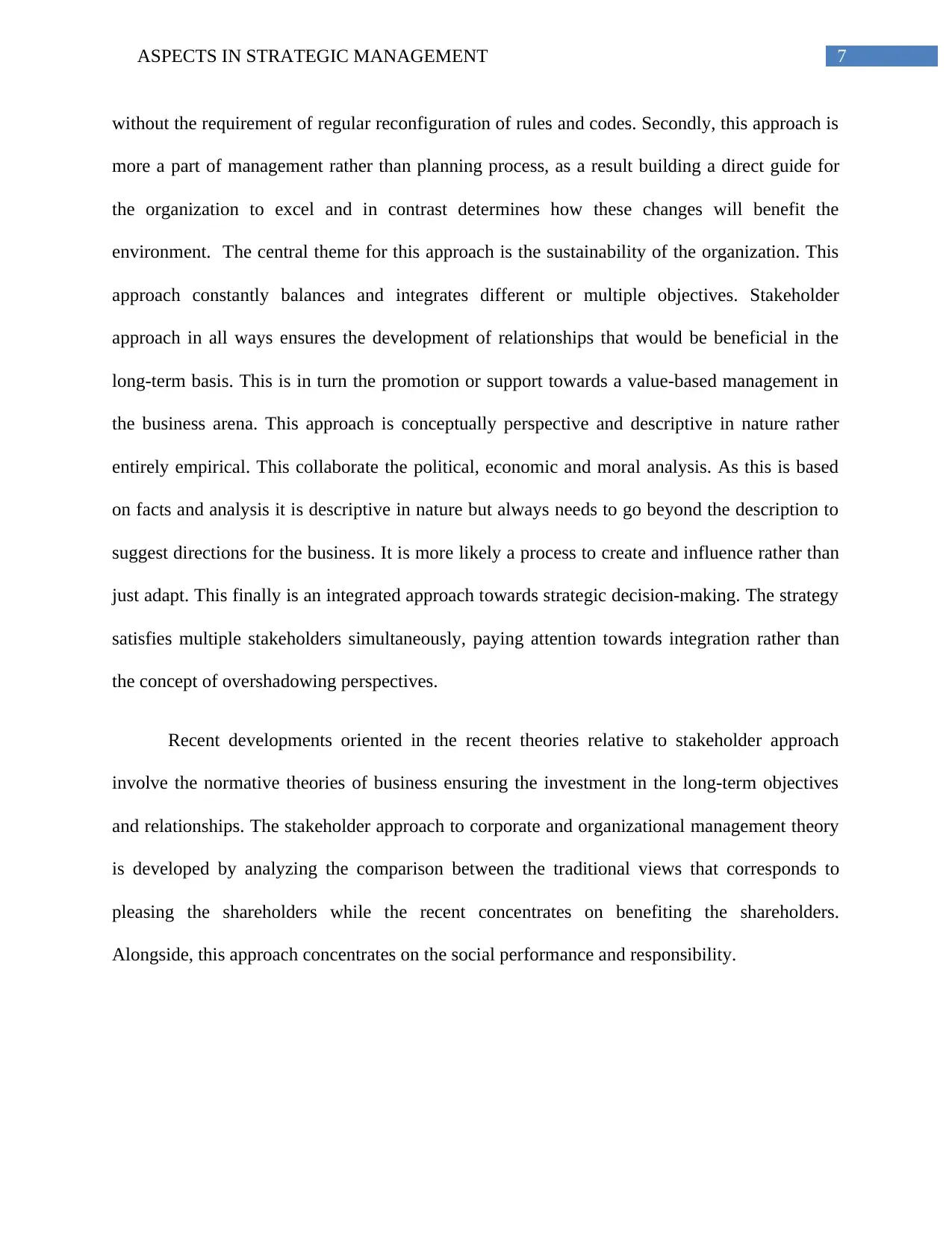
7ASPECTS IN STRATEGIC MANAGEMENT
without the requirement of regular reconfiguration of rules and codes. Secondly, this approach is
more a part of management rather than planning process, as a result building a direct guide for
the organization to excel and in contrast determines how these changes will benefit the
environment. The central theme for this approach is the sustainability of the organization. This
approach constantly balances and integrates different or multiple objectives. Stakeholder
approach in all ways ensures the development of relationships that would be beneficial in the
long-term basis. This is in turn the promotion or support towards a value-based management in
the business arena. This approach is conceptually perspective and descriptive in nature rather
entirely empirical. This collaborate the political, economic and moral analysis. As this is based
on facts and analysis it is descriptive in nature but always needs to go beyond the description to
suggest directions for the business. It is more likely a process to create and influence rather than
just adapt. This finally is an integrated approach towards strategic decision-making. The strategy
satisfies multiple stakeholders simultaneously, paying attention towards integration rather than
the concept of overshadowing perspectives.
Recent developments oriented in the recent theories relative to stakeholder approach
involve the normative theories of business ensuring the investment in the long-term objectives
and relationships. The stakeholder approach to corporate and organizational management theory
is developed by analyzing the comparison between the traditional views that corresponds to
pleasing the shareholders while the recent concentrates on benefiting the shareholders.
Alongside, this approach concentrates on the social performance and responsibility.
without the requirement of regular reconfiguration of rules and codes. Secondly, this approach is
more a part of management rather than planning process, as a result building a direct guide for
the organization to excel and in contrast determines how these changes will benefit the
environment. The central theme for this approach is the sustainability of the organization. This
approach constantly balances and integrates different or multiple objectives. Stakeholder
approach in all ways ensures the development of relationships that would be beneficial in the
long-term basis. This is in turn the promotion or support towards a value-based management in
the business arena. This approach is conceptually perspective and descriptive in nature rather
entirely empirical. This collaborate the political, economic and moral analysis. As this is based
on facts and analysis it is descriptive in nature but always needs to go beyond the description to
suggest directions for the business. It is more likely a process to create and influence rather than
just adapt. This finally is an integrated approach towards strategic decision-making. The strategy
satisfies multiple stakeholders simultaneously, paying attention towards integration rather than
the concept of overshadowing perspectives.
Recent developments oriented in the recent theories relative to stakeholder approach
involve the normative theories of business ensuring the investment in the long-term objectives
and relationships. The stakeholder approach to corporate and organizational management theory
is developed by analyzing the comparison between the traditional views that corresponds to
pleasing the shareholders while the recent concentrates on benefiting the shareholders.
Alongside, this approach concentrates on the social performance and responsibility.
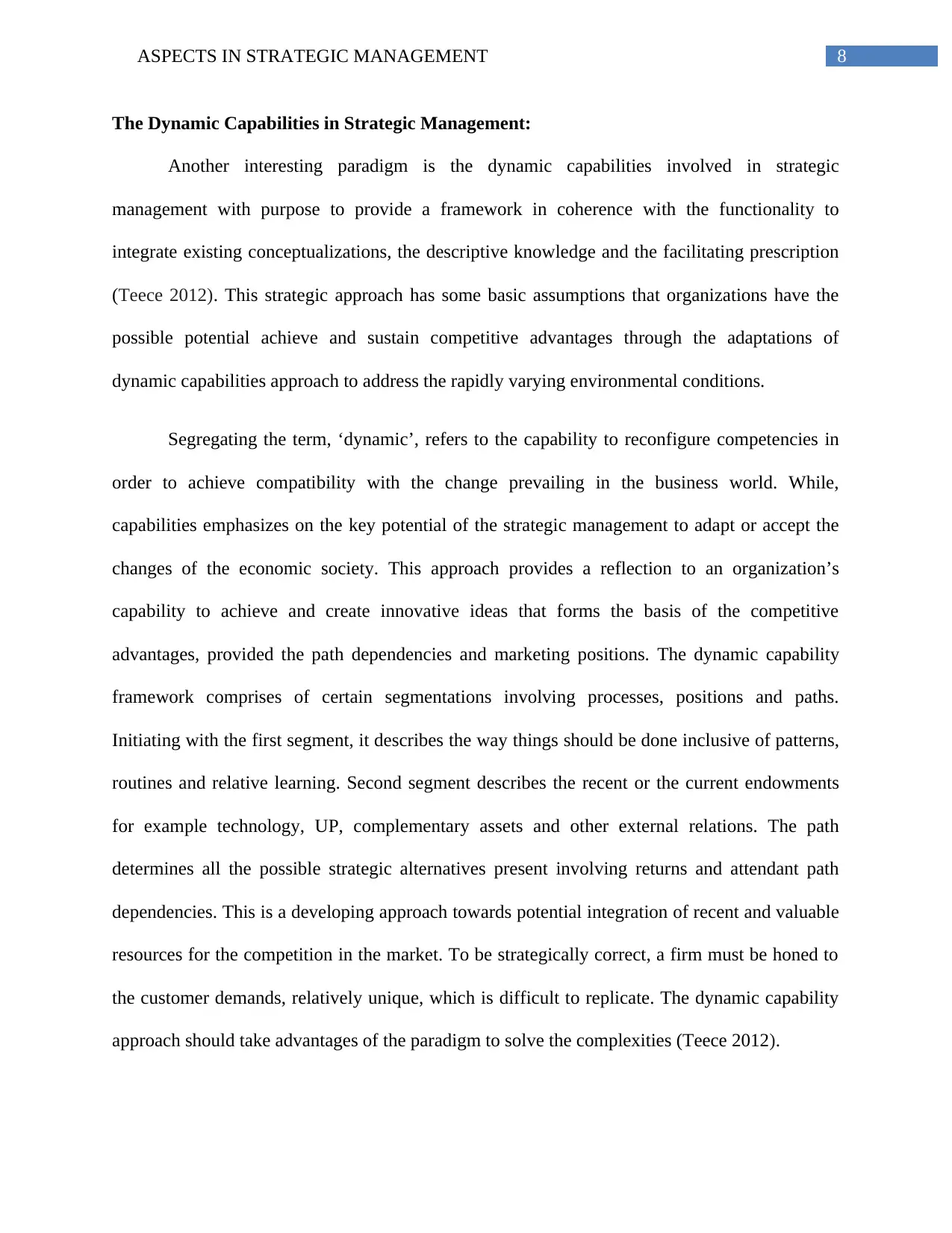
8ASPECTS IN STRATEGIC MANAGEMENT
The Dynamic Capabilities in Strategic Management:
Another interesting paradigm is the dynamic capabilities involved in strategic
management with purpose to provide a framework in coherence with the functionality to
integrate existing conceptualizations, the descriptive knowledge and the facilitating prescription
(Teece 2012). This strategic approach has some basic assumptions that organizations have the
possible potential achieve and sustain competitive advantages through the adaptations of
dynamic capabilities approach to address the rapidly varying environmental conditions.
Segregating the term, ‘dynamic’, refers to the capability to reconfigure competencies in
order to achieve compatibility with the change prevailing in the business world. While,
capabilities emphasizes on the key potential of the strategic management to adapt or accept the
changes of the economic society. This approach provides a reflection to an organization’s
capability to achieve and create innovative ideas that forms the basis of the competitive
advantages, provided the path dependencies and marketing positions. The dynamic capability
framework comprises of certain segmentations involving processes, positions and paths.
Initiating with the first segment, it describes the way things should be done inclusive of patterns,
routines and relative learning. Second segment describes the recent or the current endowments
for example technology, UP, complementary assets and other external relations. The path
determines all the possible strategic alternatives present involving returns and attendant path
dependencies. This is a developing approach towards potential integration of recent and valuable
resources for the competition in the market. To be strategically correct, a firm must be honed to
the customer demands, relatively unique, which is difficult to replicate. The dynamic capability
approach should take advantages of the paradigm to solve the complexities (Teece 2012).
The Dynamic Capabilities in Strategic Management:
Another interesting paradigm is the dynamic capabilities involved in strategic
management with purpose to provide a framework in coherence with the functionality to
integrate existing conceptualizations, the descriptive knowledge and the facilitating prescription
(Teece 2012). This strategic approach has some basic assumptions that organizations have the
possible potential achieve and sustain competitive advantages through the adaptations of
dynamic capabilities approach to address the rapidly varying environmental conditions.
Segregating the term, ‘dynamic’, refers to the capability to reconfigure competencies in
order to achieve compatibility with the change prevailing in the business world. While,
capabilities emphasizes on the key potential of the strategic management to adapt or accept the
changes of the economic society. This approach provides a reflection to an organization’s
capability to achieve and create innovative ideas that forms the basis of the competitive
advantages, provided the path dependencies and marketing positions. The dynamic capability
framework comprises of certain segmentations involving processes, positions and paths.
Initiating with the first segment, it describes the way things should be done inclusive of patterns,
routines and relative learning. Second segment describes the recent or the current endowments
for example technology, UP, complementary assets and other external relations. The path
determines all the possible strategic alternatives present involving returns and attendant path
dependencies. This is a developing approach towards potential integration of recent and valuable
resources for the competition in the market. To be strategically correct, a firm must be honed to
the customer demands, relatively unique, which is difficult to replicate. The dynamic capability
approach should take advantages of the paradigm to solve the complexities (Teece 2012).
⊘ This is a preview!⊘
Do you want full access?
Subscribe today to unlock all pages.

Trusted by 1+ million students worldwide
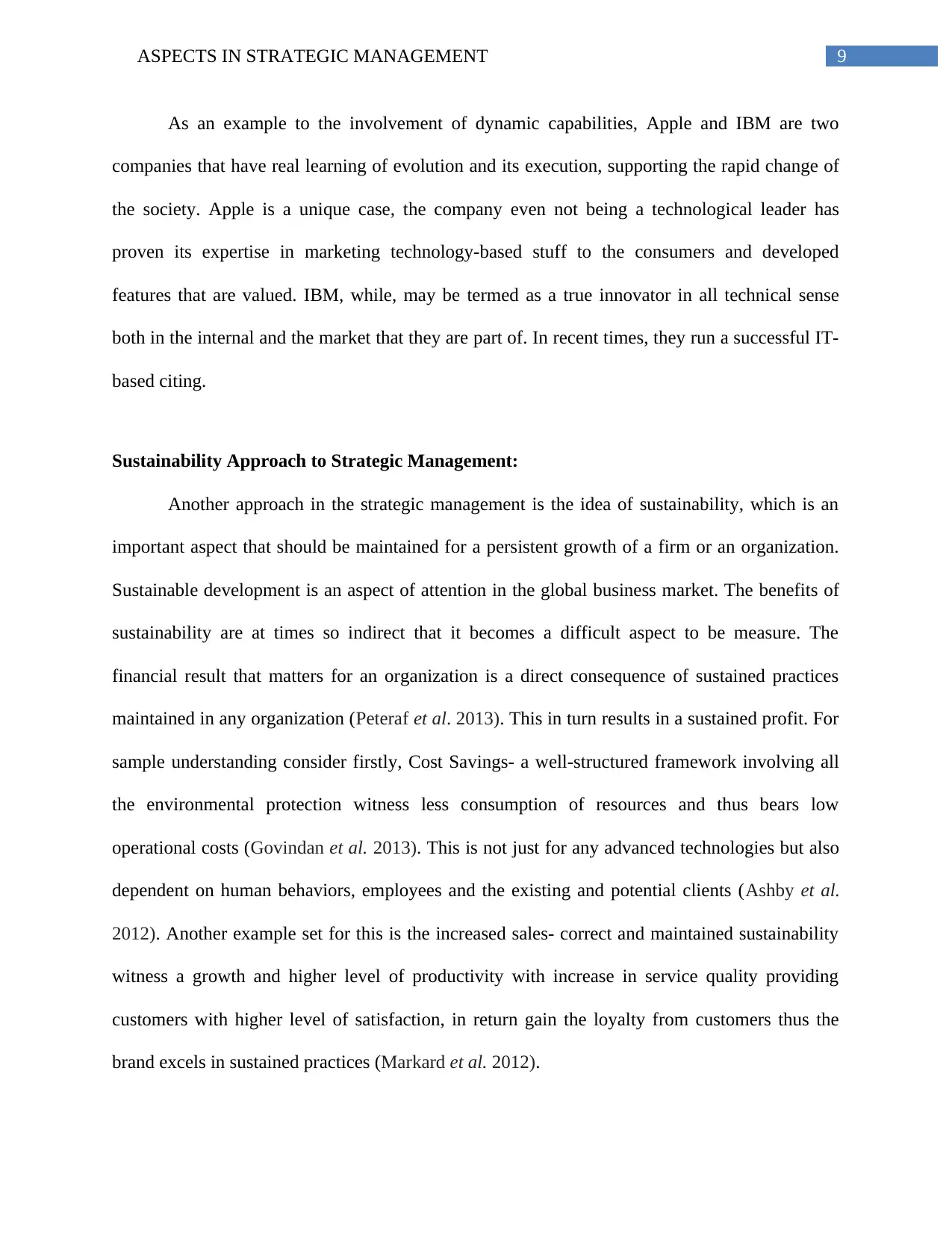
9ASPECTS IN STRATEGIC MANAGEMENT
As an example to the involvement of dynamic capabilities, Apple and IBM are two
companies that have real learning of evolution and its execution, supporting the rapid change of
the society. Apple is a unique case, the company even not being a technological leader has
proven its expertise in marketing technology-based stuff to the consumers and developed
features that are valued. IBM, while, may be termed as a true innovator in all technical sense
both in the internal and the market that they are part of. In recent times, they run a successful IT-
based citing.
Sustainability Approach to Strategic Management:
Another approach in the strategic management is the idea of sustainability, which is an
important aspect that should be maintained for a persistent growth of a firm or an organization.
Sustainable development is an aspect of attention in the global business market. The benefits of
sustainability are at times so indirect that it becomes a difficult aspect to be measure. The
financial result that matters for an organization is a direct consequence of sustained practices
maintained in any organization (Peteraf et al. 2013). This in turn results in a sustained profit. For
sample understanding consider firstly, Cost Savings- a well-structured framework involving all
the environmental protection witness less consumption of resources and thus bears low
operational costs (Govindan et al. 2013). This is not just for any advanced technologies but also
dependent on human behaviors, employees and the existing and potential clients (Ashby et al.
2012). Another example set for this is the increased sales- correct and maintained sustainability
witness a growth and higher level of productivity with increase in service quality providing
customers with higher level of satisfaction, in return gain the loyalty from customers thus the
brand excels in sustained practices (Markard et al. 2012).
As an example to the involvement of dynamic capabilities, Apple and IBM are two
companies that have real learning of evolution and its execution, supporting the rapid change of
the society. Apple is a unique case, the company even not being a technological leader has
proven its expertise in marketing technology-based stuff to the consumers and developed
features that are valued. IBM, while, may be termed as a true innovator in all technical sense
both in the internal and the market that they are part of. In recent times, they run a successful IT-
based citing.
Sustainability Approach to Strategic Management:
Another approach in the strategic management is the idea of sustainability, which is an
important aspect that should be maintained for a persistent growth of a firm or an organization.
Sustainable development is an aspect of attention in the global business market. The benefits of
sustainability are at times so indirect that it becomes a difficult aspect to be measure. The
financial result that matters for an organization is a direct consequence of sustained practices
maintained in any organization (Peteraf et al. 2013). This in turn results in a sustained profit. For
sample understanding consider firstly, Cost Savings- a well-structured framework involving all
the environmental protection witness less consumption of resources and thus bears low
operational costs (Govindan et al. 2013). This is not just for any advanced technologies but also
dependent on human behaviors, employees and the existing and potential clients (Ashby et al.
2012). Another example set for this is the increased sales- correct and maintained sustainability
witness a growth and higher level of productivity with increase in service quality providing
customers with higher level of satisfaction, in return gain the loyalty from customers thus the
brand excels in sustained practices (Markard et al. 2012).
Paraphrase This Document
Need a fresh take? Get an instant paraphrase of this document with our AI Paraphraser
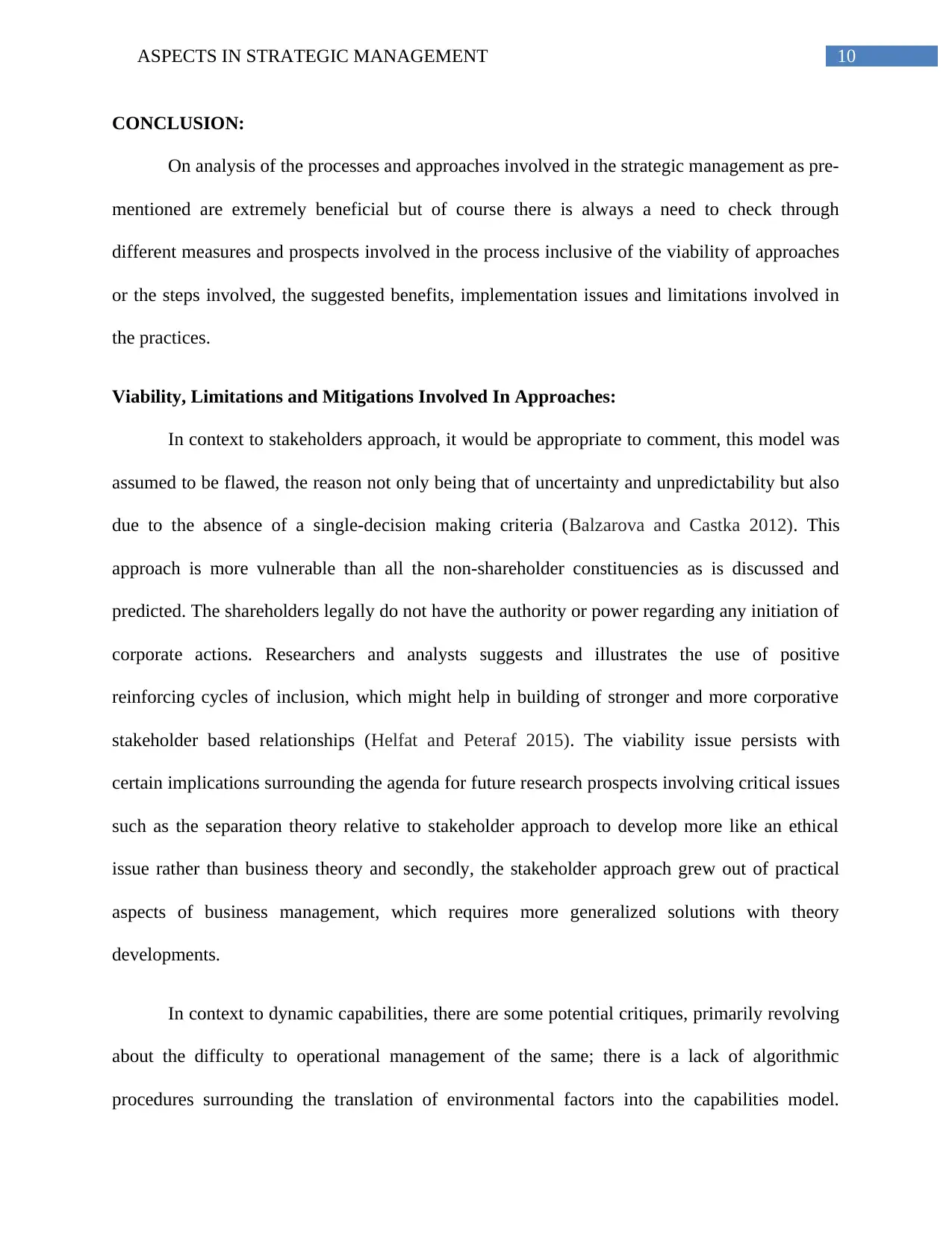
10ASPECTS IN STRATEGIC MANAGEMENT
CONCLUSION:
On analysis of the processes and approaches involved in the strategic management as pre-
mentioned are extremely beneficial but of course there is always a need to check through
different measures and prospects involved in the process inclusive of the viability of approaches
or the steps involved, the suggested benefits, implementation issues and limitations involved in
the practices.
Viability, Limitations and Mitigations Involved In Approaches:
In context to stakeholders approach, it would be appropriate to comment, this model was
assumed to be flawed, the reason not only being that of uncertainty and unpredictability but also
due to the absence of a single-decision making criteria (Balzarova and Castka 2012). This
approach is more vulnerable than all the non-shareholder constituencies as is discussed and
predicted. The shareholders legally do not have the authority or power regarding any initiation of
corporate actions. Researchers and analysts suggests and illustrates the use of positive
reinforcing cycles of inclusion, which might help in building of stronger and more corporative
stakeholder based relationships (Helfat and Peteraf 2015). The viability issue persists with
certain implications surrounding the agenda for future research prospects involving critical issues
such as the separation theory relative to stakeholder approach to develop more like an ethical
issue rather than business theory and secondly, the stakeholder approach grew out of practical
aspects of business management, which requires more generalized solutions with theory
developments.
In context to dynamic capabilities, there are some potential critiques, primarily revolving
about the difficulty to operational management of the same; there is a lack of algorithmic
procedures surrounding the translation of environmental factors into the capabilities model.
CONCLUSION:
On analysis of the processes and approaches involved in the strategic management as pre-
mentioned are extremely beneficial but of course there is always a need to check through
different measures and prospects involved in the process inclusive of the viability of approaches
or the steps involved, the suggested benefits, implementation issues and limitations involved in
the practices.
Viability, Limitations and Mitigations Involved In Approaches:
In context to stakeholders approach, it would be appropriate to comment, this model was
assumed to be flawed, the reason not only being that of uncertainty and unpredictability but also
due to the absence of a single-decision making criteria (Balzarova and Castka 2012). This
approach is more vulnerable than all the non-shareholder constituencies as is discussed and
predicted. The shareholders legally do not have the authority or power regarding any initiation of
corporate actions. Researchers and analysts suggests and illustrates the use of positive
reinforcing cycles of inclusion, which might help in building of stronger and more corporative
stakeholder based relationships (Helfat and Peteraf 2015). The viability issue persists with
certain implications surrounding the agenda for future research prospects involving critical issues
such as the separation theory relative to stakeholder approach to develop more like an ethical
issue rather than business theory and secondly, the stakeholder approach grew out of practical
aspects of business management, which requires more generalized solutions with theory
developments.
In context to dynamic capabilities, there are some potential critiques, primarily revolving
about the difficulty to operational management of the same; there is a lack of algorithmic
procedures surrounding the translation of environmental factors into the capabilities model.
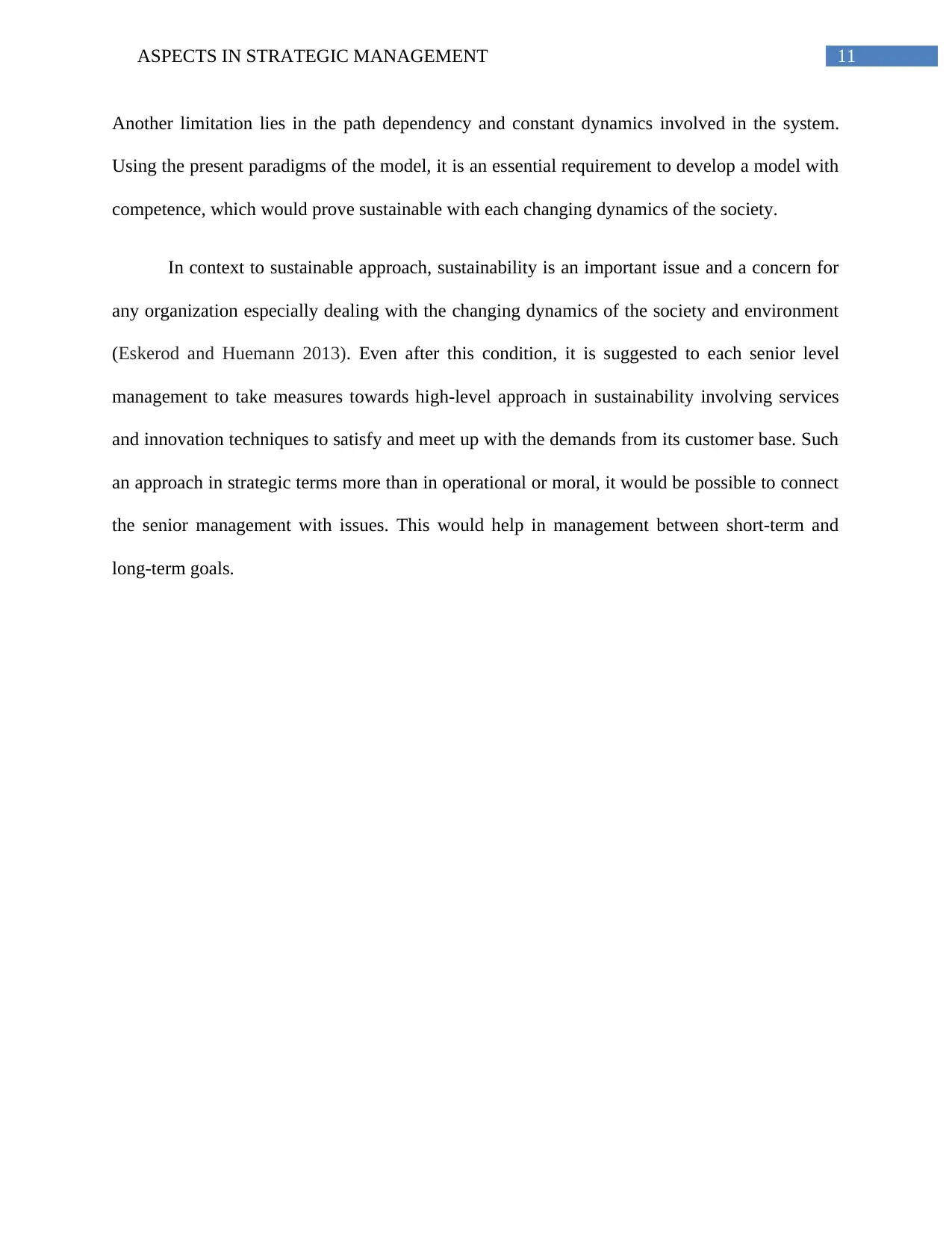
11ASPECTS IN STRATEGIC MANAGEMENT
Another limitation lies in the path dependency and constant dynamics involved in the system.
Using the present paradigms of the model, it is an essential requirement to develop a model with
competence, which would prove sustainable with each changing dynamics of the society.
In context to sustainable approach, sustainability is an important issue and a concern for
any organization especially dealing with the changing dynamics of the society and environment
(Eskerod and Huemann 2013). Even after this condition, it is suggested to each senior level
management to take measures towards high-level approach in sustainability involving services
and innovation techniques to satisfy and meet up with the demands from its customer base. Such
an approach in strategic terms more than in operational or moral, it would be possible to connect
the senior management with issues. This would help in management between short-term and
long-term goals.
Another limitation lies in the path dependency and constant dynamics involved in the system.
Using the present paradigms of the model, it is an essential requirement to develop a model with
competence, which would prove sustainable with each changing dynamics of the society.
In context to sustainable approach, sustainability is an important issue and a concern for
any organization especially dealing with the changing dynamics of the society and environment
(Eskerod and Huemann 2013). Even after this condition, it is suggested to each senior level
management to take measures towards high-level approach in sustainability involving services
and innovation techniques to satisfy and meet up with the demands from its customer base. Such
an approach in strategic terms more than in operational or moral, it would be possible to connect
the senior management with issues. This would help in management between short-term and
long-term goals.
⊘ This is a preview!⊘
Do you want full access?
Subscribe today to unlock all pages.

Trusted by 1+ million students worldwide
1 out of 15
Related Documents
Your All-in-One AI-Powered Toolkit for Academic Success.
+13062052269
info@desklib.com
Available 24*7 on WhatsApp / Email
![[object Object]](/_next/static/media/star-bottom.7253800d.svg)
Unlock your academic potential
Copyright © 2020–2025 A2Z Services. All Rights Reserved. Developed and managed by ZUCOL.




